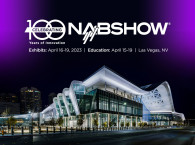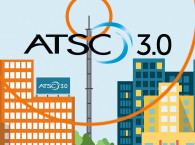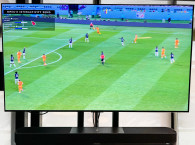Next-generation broadcast television moves a step closer to reality at the upcoming 2016 NAB Show (Las Vegas, April 16-21, 2016), when live transmissions originating from the show floor reach prototype receivers designed to demonstrate the myriad new capabilities of ATSC 3.0. Four days of NAB Show exhibits at the Las Vegas Convention Center (LVCC) open Monday, April 18.

“The monumental effort underway to standardize ATSC 3.0 is nearing completion, with more than 20 elements of the new standard in play. Hundreds of volunteer experts have been working to develop the world’s first broadcast standard built with an IP (Internet Protocol) backbone, and we’re excited to see the many capabilities of this next-generation broadcasting platform at the upcoming NAB Show,” says ATSC President Mark Richer.
ATSC 3.0 Broadcast Pavilion
Key technologies for broadcasters will be part of the ATSC 3.0 Broadcast Pavilion as a highlight of the Futures Park exhibition in the east end of South Hall, Upper Level. In addition to a live transmission from a small studio in the Futures Park, the Pavilion will feature a variety of new broadcast equipment options from various companies, including signal analyzers, multiplexers, transmission equipment for HDR (High Dynamic Range) content, encoders for SFN (Single Frequency Network) transmissions, audio encoders, watermarking software, Interactive TV applications and more.
“ATSC 3.0 has the potential to strengthen broadcasters’ ability to provide a richer and more personalized content experiences for viewers,” said Sam Matheny, Chief Technology Officer, National Association of Broadcasters. “The progress that ATSC has made in developing a new standard has been remarkable, and we look forward to showcasing next-generation TV technology at NAB Show.”
ATSC 3.0 Consumer Experience
Among the demonstrations planned for the “ATSC 3.0 Consumer Experience,” located near the entrance to the upper level of the LVCC’s South Hall, will be new receiving devices for next-generation television broadcasts, ATSC 3.0 “gateway” receivers that will feed existing tablets and mobile devices with Wi-Fi signals, captivating next-generation TV audio demonstrations, and examples of how ATSC 3.0’s advanced emergency alerting will deliver more information to viewers during times of crisis. Reception of live ATSC 3.0 transmissions originating from the Futures Park will also be displayed.
“Consumer technology companies are poised to sell millions of 4K UHDTV receivers this year, as new capabilities such as HDR begin to populate the most advanced products. Consumers are hungry for new sources of 4K content, and we expect to see several examples of new product capabilities shown for the first time in the ATSC 3.0 Consumer Experience display,” says Jeff Joseph, Senior Vice President, Consumer Technology Association.
ATSC 3.0 Broadcast Live in Korea
In February 2016, LG Electronics promoted the world’s first end-to-end 4K broadcast using the next-generation ATSC 3.0 standard. Conducted in Korea, the test broadcast was a joint project of LG, Korean broadcasters SBS and MBC, the Electronics and Telecommunications Research Institute (ETRI) of Korea, conditional access firm DigiCAP of Korea, broadcast equipment supplier TeamCast of France, and video software supplier Media Excel of the United States.
Being developed as a global standard by the Advanced Television Systems Committee, ATSC 3.0 is also the world’s first Internet Protocol (IP) based broadcast system, combining broadcasting and broadband for the first time. Most of the 20 elements that comprise the ATSC standard have now moved to Candidate Standard status, one of the last steps in the standardization process.

The first end-to-end broadcast of 4K Ultra HD represents a significant development, because past demonstrations have simply used pre-recorded material loaded directly to a transmitter. This test broadcast featured a live camera feed with real-time IP transmissions from the SBS network studio in Mokdong to the broadcaster’s Gwanak Mountain transmitter. The IP signals transmitted over the air on Channel 53 were then received using a simple antenna and decoded by a 4K Ultra HDTV ATSC 3.0 receiver developed by LG Electronics.
Dr. Young-Soo Park, SBS technical director, said, “The success of this trial highlights the potential for Korea’s launch of terrestrial UHD TV commercial services using ATSC 3.0 in February 2017. And the fact that Korean companies are playing such an important role in ATSC 3.0 provides a good opportunity for Korean equipment manufacturers to advance in the U.S. market.”
Signals in the Korean broadcast were delivered with next-generation IP technologies based on the DASH (Dynamic Adaptive Streaming over HTTP) streaming media format and ROUTE (Real-Time Object Delivery Over Unidirectional Transport) IP delivery protocol.
SBS coordinated a combination of broadcast equipment and systems, including the 4K video server, ROUTE-based HEVC (High Efficiency Video Coding) encoder, ROUTE-based multiplexer, signaling server, and ATSC 3.0 management system, all of which were used for the broadcasting demonstration. MBC participated in the broadcast transmission interface and reception measurement testing. DigiCap provided the ATSC 3.0 signaling server, and Media Excel provided the HEVC real-time encoder.
Following the success of the experimental broadcast, SBS and MBC plan to work with LG and ETRI to take full advantage of new capabilities of ATSC 3.0, such as the combination of broadcast and broadband signals. “We will continue to develop technologies to help commercialize ATSC 3.0 as the next great advance in terrestrial broadcasting,” said Dr. K.Y. Kwak, executive vice president, LG’s Advanced Standard Research & Development Lab.
www.lg.com
www.nabshow.com






